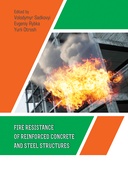Explore

Fire resistance of reinforced concrete and steel structures
0 Ungluers have
Faved this Work
Login to Fave
The scientific bases of ensuring fire resistance of reinforced concrete and steel building structures in the conditions of modern extreme influences are laid.
The current state of fire safety of buildings and structures, as well as approaches, methods and tools for its assessment are analyzed. Analysis of emergencies and fires in the world has shown that the vast majority of them occur in buildings and structures. It is shown that the cause of catastrophic consequences and destruction is the non-compliance of the actual limit of fire resistance of building structures with regulatory requirements. This is due to the imperfection of methods and means of assessing the fire resistance of building structures, including fire-retardant.
To overcome the shortcomings identified during the analysis, the paper develops physical and mathematical models of thermal processes occurring in the fire-retardant reinforced concrete structure. Based on the proposed models, a computational-experimental method for estimating the fire resistance of such structures has been developed. The efficiency of the proposed method was tested by identifying the relationship between the parameters of the fire-retardant plaster coating “Neospray” and the fire resistance of fire-retardant multi-hollow reinforced concrete floor.
The study of fire resistance of steel structures is proposed to be carried out using reduced samples in the form of steel plates with dimensions of 500×500×5 mm. Based on the proposed models, a calculation and experimental method for estimating the fire resistance of steel structures, as well as an algorithm and procedures for its implementation have been developed. The verification of the efficiency of the proposed method was carried out in the ANSYS software package using the aged coating “Phoenix STS” and the coating “Amotherm Steel Wb” under heating conditions at the temperature of the hydrocarbon fire.
The reliability of the developed models and methods is checked. It is established that random errors in temperature measurement significantly affect the accuracy of determining the thermophysical characteristics and limits of fire resistance. In general, the efficiency of the proposed calculation and experimental methods with sufficient accuracy for engineering calculations is confirmed.
This book is included in DOAB.
Why read this book? Have your say.
You must be logged in to comment.
Editions

